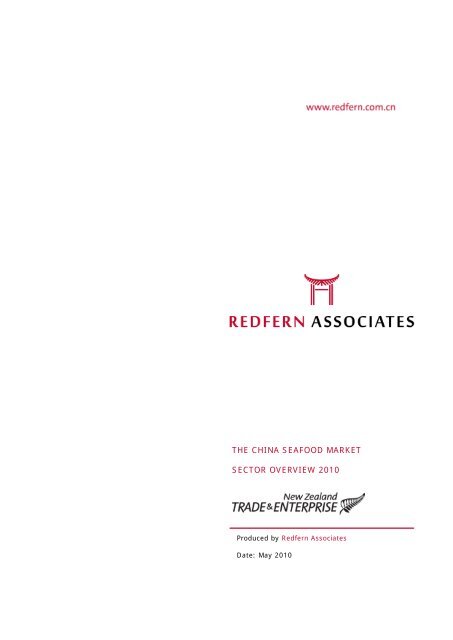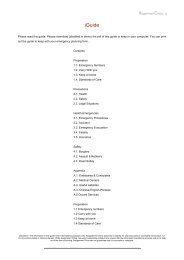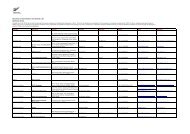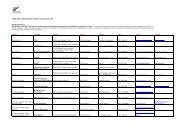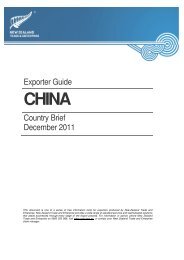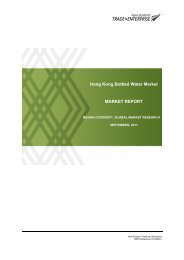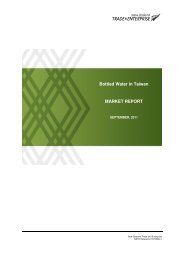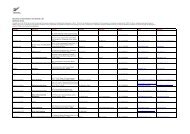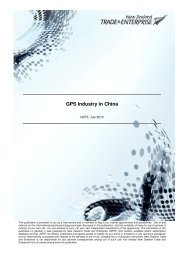Seafood Market in China - China Fisheries & Seafood Expo
Seafood Market in China - China Fisheries & Seafood Expo
Seafood Market in China - China Fisheries & Seafood Expo
You also want an ePaper? Increase the reach of your titles
YUMPU automatically turns print PDFs into web optimized ePapers that Google loves.
THE CHINA SEAFOOD MARKET<br />
SECTOR OVERVIEW 2010<br />
Produced by Redfern Associates<br />
Date: May 2010
THE CHINA SEAFOOD MARKET OVERVIEW<br />
TABLE OF CONTENTS<br />
1. MARKET OVERVIEW 3<br />
2. MARKET CHANNELS 6<br />
2.1 Live <strong>Seafood</strong> 6<br />
2.2 Frozen <strong>Seafood</strong> 8<br />
3. VALUE CHAIN 10<br />
3.1 Live <strong>Seafood</strong> 10<br />
3.2 Frozen <strong>Seafood</strong> 11<br />
4. CHINA-NZ FREE TRADE AGREEMENT 12<br />
5. IMPORTATION PROCESS 13<br />
6. REGULATORY, LABELLING AND LICENSING RESTRICTIONS 14<br />
7. APPENDIX<br />
- CHINA SEAFOOD MARKET DIAGRAM 16<br />
- CHINA MAP 17<br />
02<br />
Ch<strong>in</strong>a <strong>Seafood</strong> Report 2010
1. MARKET OVERVIEW<br />
Ch<strong>in</strong>a is one of the world's seafood superpowers. It is the largest consumer, importer, exporter and<br />
producer of seafood <strong>in</strong> the world, represent<strong>in</strong>g approximately 35% of total global production. Ch<strong>in</strong>a<br />
is also the largest producer of aquaculture products <strong>in</strong> the world, and the only country <strong>in</strong> the world<br />
where farmed fish production exceeds wild catch.<br />
Accord<strong>in</strong>g to Ch<strong>in</strong>ese M<strong>in</strong>istry of Agriculture (MOA), Ch<strong>in</strong>a's annual aquatic production is<br />
approximately 60 million tonnes, and per capita consumption of aquatic products is approximately<br />
12kg. Due to the large amount of seafood processed for re-export, some <strong>in</strong>dustry figures even<br />
po<strong>in</strong>t to a number as high as 26kg/capita <strong>in</strong> 2006. Accord<strong>in</strong>g to the National Statistics Bureau,<br />
Aquatic consumption per capital <strong>in</strong>creased 130% <strong>in</strong> the 10 years from 1998 to 2008.<br />
Ch<strong>in</strong>a is also a major player <strong>in</strong> the <strong>in</strong>ternational seafood trade. Due to the country’s steady<br />
economic growth, its exports of seafood are <strong>in</strong>creas<strong>in</strong>g every year. Based on World Trade Atlas<br />
(WTA) data, <strong>in</strong> 2009, Ch<strong>in</strong>a exported fish and seafood to the value of US$6.81bn, a rise of 31%<br />
from US$5.18bn <strong>in</strong> 2008. In the past 10 years, the steady growth <strong>in</strong> Ch<strong>in</strong>a’s seafood exports has<br />
created a huge surplus <strong>in</strong> the seafood trade.<br />
CHINA’S SEAFOOD IMPORTS<br />
Ch<strong>in</strong>ese imports of fish and seafood were valued at US$3.60b <strong>in</strong> 2009, down from US$3.65bn <strong>in</strong><br />
2008, accord<strong>in</strong>g to WTA data. However, imports are expected to <strong>in</strong>crease together with consumer<br />
purchas<strong>in</strong>g power <strong>in</strong> 2010. Ch<strong>in</strong>ese seafood imports can be separated <strong>in</strong>to three ma<strong>in</strong> categories:<br />
1. Higher value seafood for domestic consumption e.g. live lobster and oysters.<br />
2. Fishmeal to meet part of the need for animal and fish feed.<br />
3. <strong>Seafood</strong> to be re-processed for exports e.g. hoki, roughy, dory and squid.<br />
Russia is expected to cont<strong>in</strong>ue to top the list of countries of orig<strong>in</strong> for Ch<strong>in</strong>a’s fish and seafood<br />
imports. It has headed the list for the past seven years consecutively, with the closest competitors<br />
- the United States, Norway and Japan - all lagg<strong>in</strong>g far beh<strong>in</strong>d. Shandong is the ma<strong>in</strong> seafood<br />
process<strong>in</strong>g prov<strong>in</strong>ce <strong>in</strong> Ch<strong>in</strong>a, and the prov<strong>in</strong>cial capital Q<strong>in</strong>gdao is the number one dest<strong>in</strong>ation for<br />
seafood imported from New Zealand, as well as imported seafood <strong>in</strong> general.<br />
Major Ports of Entry for New Zealand <strong>Seafood</strong> 2009 (USD)<br />
Others, 5m<br />
Shenzhen, 6m<br />
Dalian, 16m<br />
Q<strong>in</strong>gdao, 48m<br />
Source: WTA<br />
03<br />
Ch<strong>in</strong>a <strong>Seafood</strong> Report 2010
NEW ZEALAND SEAFOOD EXPORTS TO CHINA<br />
New Zealand is ranked as Ch<strong>in</strong>a’s tenth largest supplier of seafood, accord<strong>in</strong>g to WTA data. In<br />
2009, New Zealand exported US$86.78m of fish and seafood to Ch<strong>in</strong>a. Industry sources estimate<br />
over 80% of New Zealand’s seafood exports are dest<strong>in</strong>ed for process<strong>in</strong>g and re-export (the<br />
process<strong>in</strong>g trade).<br />
New Zealand’s seafood companies have the opportunity to play an <strong>in</strong>creas<strong>in</strong>gly important role <strong>in</strong><br />
engag<strong>in</strong>g and <strong>in</strong>fluenc<strong>in</strong>g the placement, position<strong>in</strong>g, quality and pric<strong>in</strong>g of their product <strong>in</strong> this<br />
market. They can enter Ch<strong>in</strong>a <strong>in</strong> a more <strong>in</strong>tegrated manner than before, <strong>in</strong>vest<strong>in</strong>g <strong>in</strong> process<strong>in</strong>g or<br />
distribution, and can play a role <strong>in</strong> the value cha<strong>in</strong> rather than simply trad<strong>in</strong>g. A number of New<br />
Zealand seafood players have already established partnerships <strong>in</strong> Ch<strong>in</strong>a with process<strong>in</strong>g companies.<br />
New Zealand <strong>Seafood</strong> <strong>Expo</strong>rts to Ch<strong>in</strong>a<br />
80<br />
70<br />
74.28<br />
US$ millions<br />
60<br />
50<br />
40<br />
30<br />
20<br />
10<br />
0<br />
9.74<br />
1.01 1.75<br />
Frozen fish Squid Mussel Other seafood<br />
<strong>Seafood</strong> category<br />
Source: WTA<br />
CHINESE CONSUMER PREFERENCES<br />
The Ch<strong>in</strong>ese consumer has a voracious appetite for seafood of all k<strong>in</strong>ds, <strong>in</strong>clud<strong>in</strong>g live, frozen and<br />
further processed products. <strong>Seafood</strong> consumption <strong>in</strong> Ch<strong>in</strong>a is expected to reach 35.9kg/capita <strong>in</strong><br />
2020, accord<strong>in</strong>g to the Food and Agriculture Organization (FAO). Consumption is ris<strong>in</strong>g <strong>in</strong> l<strong>in</strong>e with<br />
<strong>in</strong>creas<strong>in</strong>g purchas<strong>in</strong>g power and a strong preference for seafood among Ch<strong>in</strong>ese consumers, the<br />
Glitnir Ch<strong>in</strong>a <strong>Seafood</strong> Industry Report states.<br />
Live freshwater fish leads demand <strong>in</strong> <strong>in</strong>land city markets, while frozen and processed products are<br />
more common <strong>in</strong> northern regions. Live ocean catch is popular amongst the wealthy elite of Ch<strong>in</strong>a’s<br />
boom<strong>in</strong>g east coast, and this demographic consumes a great proportion of New Zealand’s lobsters.<br />
Imported seafood is highly esteemed by Ch<strong>in</strong>ese consumers. Live seafood, especially lobster and<br />
abalone are symbols of luxury. Little brand<strong>in</strong>g of live seafood takes place <strong>in</strong> Ch<strong>in</strong>a, but there is an<br />
<strong>in</strong>creas<strong>in</strong>g awareness of country of orig<strong>in</strong> and quality of product. Important associations <strong>in</strong>clude:<br />
• Canada: Dungeness crab, oysters, lobster, and surf clams<br />
• Australia: Rock lobster, crab, oyster, and abalone<br />
• New Zealand: Rock lobster, mussel, and abalone<br />
04<br />
Ch<strong>in</strong>a <strong>Seafood</strong> Report 2010
HORECA - HOTELS, RESTAURANTS, CAFES<br />
New Zealand’s seafood presence <strong>in</strong> Ch<strong>in</strong>ese restaurants is best illustrated by Rock Lobster. Highend<br />
Ch<strong>in</strong>ese restaurants sell rock lobsters as a luxury product. S<strong>in</strong>ce Australia and New Zealand<br />
rock lobsters are homogenous, the Ch<strong>in</strong>ese consumer has been led to believe that all such lobster<br />
is from Australia. Therefore, live lobsters from New Zealand despite the actual high volumes <strong>in</strong><br />
market, rema<strong>in</strong> completely unknown at consumer level and thus are not been demanded by name.<br />
By contrast, Australia, Japan and South Africa have representative product and establish brand<br />
images. The restaurants selected below are well known, high-end Ch<strong>in</strong>ese <strong>Seafood</strong> Cha<strong>in</strong>s <strong>in</strong><br />
Shanghai city.<br />
Lobster<br />
Abalone<br />
Restaurant A Restaurant B Restaurant C Restaurant D<br />
Australia<br />
Japan<br />
Middle East<br />
Australia<br />
USA<br />
Japan<br />
South Africa<br />
Middle East<br />
Australia<br />
Japan<br />
South Africa<br />
Middle East<br />
Australia<br />
Japan<br />
Australia<br />
Mussel Ch<strong>in</strong>a Ch<strong>in</strong>a Ch<strong>in</strong>a Ch<strong>in</strong>a<br />
Clams Ch<strong>in</strong>a Ch<strong>in</strong>a Japan Japan<br />
Oyster<br />
French<br />
Ch<strong>in</strong>a<br />
USA<br />
Ch<strong>in</strong>a<br />
Canada<br />
Australia<br />
Canada<br />
Salmon Norway Norway Norway Norway<br />
Food safety has become an <strong>in</strong>creas<strong>in</strong>gly important issue <strong>in</strong> Ch<strong>in</strong>a: Due to higher liv<strong>in</strong>g standards,<br />
consumers <strong>in</strong>creas<strong>in</strong>gly prefer environmentally safe, non-polluted foods. High-end food products of<br />
better quality and well-known brands have a grow<strong>in</strong>g market share. Meanwhile, with awareness of<br />
nutritional values <strong>in</strong>creas<strong>in</strong>g among consumers, green, nutritious and healthy products will be<br />
<strong>in</strong>creas<strong>in</strong>gly popular: this arguably creates unprecedented opportunities for New Zealand food<br />
exporters.<br />
CONCLUSION<br />
Ch<strong>in</strong>a's appetite for seafood is expected to show strong growth for the foreseeable future, as the<br />
boom<strong>in</strong>g economy cont<strong>in</strong>ues to raise liv<strong>in</strong>g standards and the middle class grows. New Zealand<br />
companies have the opportunity to play an important role <strong>in</strong> the growth of this sector.<br />
05<br />
Ch<strong>in</strong>a <strong>Seafood</strong> Report 2010
2. MARKET CHANNELS<br />
2.1 LIVE SEAFOOD<br />
DISTRIBUTION PROCESS<br />
There are generally four steps <strong>in</strong> Ch<strong>in</strong>a’s distribution process: importation, distribution, subdistribution<br />
and retail. In actuality, number of stages varies, but each step serves a function which<br />
is vital for the entire channel, add<strong>in</strong>g value to the f<strong>in</strong>al product.<br />
Typical imported live seafood distribution channel <strong>in</strong> Ch<strong>in</strong>a<br />
Importer Distributor Sub-Distributor<br />
Retailer<br />
POINTS OF ENTRY AND DISTRIBUTION HUBS<br />
• Shenzhen: Most live seafood imports to Ch<strong>in</strong>a arrive <strong>in</strong> Shenzhen. Located immediately north<br />
of Hong Kong, the traditional channel for through which seafood imports to Ch<strong>in</strong>a pass,<br />
importers <strong>in</strong> Shenzhen dom<strong>in</strong>ate most of the seafood import and distribution channels<br />
throughout the country. They have built networks <strong>in</strong> various major cities, <strong>in</strong>clud<strong>in</strong>g Shanghai<br />
and Beij<strong>in</strong>g. Just under half of seafood imports enter<strong>in</strong>g Shenzhen are distributed directly<br />
through the city.<br />
• Guangzhou: Due to the city’s status as Ch<strong>in</strong>a’s third largest air transport hub after Beij<strong>in</strong>g and<br />
Shanghai, more than half of the seafood enter<strong>in</strong>g Shenzhen is sent to Guangzhou then<br />
distributed from there around Ch<strong>in</strong>a. Huangsha <strong>Seafood</strong> Wholesale <strong>Market</strong>, one of the largest<br />
seafood wholesale markets <strong>in</strong> Ch<strong>in</strong>a, is located <strong>in</strong> Guangzhou.<br />
• Shanghai is another major consumer and distribution hub due to its location, <strong>in</strong>frastructure and<br />
status as a transport hub. It is also currently the most logical po<strong>in</strong>t of entry for direct seafood<br />
importation, especially for New Zealand products, given direct flight paths.<br />
CHINA AND HONG KONG IMPORTS FROM THE WORLD<br />
Currently, New Zealand’s live seafood is ma<strong>in</strong>ly imported <strong>in</strong>to Ch<strong>in</strong>a through the traditional channel<br />
of Hong Kong. Accord<strong>in</strong>g to Hong Kong Customs, <strong>in</strong> 2009 Hong Kong imported US$53m of live<br />
lobster from New Zealand; <strong>in</strong> the same year, Ch<strong>in</strong>a only imported US$0.07m, suggest<strong>in</strong>g a<br />
significant proportion of Hong Kong’s imports are dest<strong>in</strong>ed to satisfy the demand of the ma<strong>in</strong>land<br />
Ch<strong>in</strong>ese market.<br />
2009 LOBSTER EXPORTS (USD MILLION)<br />
Ch<strong>in</strong>a Import<br />
Australia<br />
New Zealand<br />
0.06<br />
0.07<br />
113<br />
53<br />
South Africa<br />
U.S.<br />
2.7<br />
0.25<br />
30<br />
25<br />
Mexico<br />
Indonesia<br />
0.28<br />
2.5<br />
5<br />
8<br />
Thailand 4.5 -<br />
Hong Kong Import<br />
06<br />
Ch<strong>in</strong>a <strong>Seafood</strong> Report 2010
Yet accord<strong>in</strong>g to The New Zealand <strong>Seafood</strong> Industry Council (and New Zealand Customs) the total<br />
lobster export figure for the same year was NZ$180m and over 90% of which is dest<strong>in</strong>ed for Ch<strong>in</strong>a.<br />
By contrast, some Canadian and Boston lobster, amongst others, is imported directly to ma<strong>in</strong>land<br />
Ch<strong>in</strong>a.<br />
SEAFOOD MARKETS<br />
Live seafood distribution <strong>in</strong> Ch<strong>in</strong>a is traditionally dom<strong>in</strong>ated by seafood markets. Accord<strong>in</strong>g to FAO,<br />
more than 340 live seafood markets exist across Ch<strong>in</strong>a. Fish brokers rent booths and trade as both<br />
wholesalers and retailers.<br />
Such seafood markets are typically large <strong>in</strong> size and provide a varied range of seafood products.<br />
Important examples <strong>in</strong>clude:<br />
• Shenzhen Yantian <strong>Seafood</strong> <strong>Market</strong>: It is estimated that 90% of imported live seafood enters<br />
Ch<strong>in</strong>a via this seafood market. All companies present <strong>in</strong> Yantian have tank facilities to store<br />
sizeable volumes of live seafood before re-packag<strong>in</strong>g and freight<strong>in</strong>g the product to other<br />
markets <strong>in</strong> Ch<strong>in</strong>a.<br />
• Guangzhou Huangsha <strong>Seafood</strong> Wholesale <strong>Market</strong>: One of Ch<strong>in</strong>a’s largest seafood markets, it<br />
handles both imported seafood and domestic products <strong>in</strong> all formats, i.e. live, chilled and frozen.<br />
The market was established <strong>in</strong> 1994 and has transaction area larger than 40,000 square<br />
meters. Imported seafood products are sourced from many countries <strong>in</strong>clud<strong>in</strong>g Canada, the U.S,<br />
Australia, New Zealand and ASEAN countries. The market also acts as the major hub for exports<br />
to other areas <strong>in</strong> Ch<strong>in</strong>a, especially southern Ch<strong>in</strong>a.<br />
• Shanghai Tong Chuan <strong>Seafood</strong> <strong>Market</strong>: The market covers 26,000 square meters, with 700<br />
booths and 100 shops, and is the largest <strong>in</strong> the city. 90% of lead<strong>in</strong>g live seafood importers and<br />
distributors have established their offices and booths with swimm<strong>in</strong>g facilities (tanks) and<br />
warehouses. Companies <strong>in</strong> this market deal with 17 countries and regions, <strong>in</strong>clud<strong>in</strong>g the United<br />
States, Japan, Norway, Thailand, Vietnam, Taiwan and Hong Kong.<br />
DISTRIBUTORS<br />
Distributors and sub-distributors normally have a resident booth at seafood markets. Distributors<br />
and sub-distributors often assume the role of warehouse as well: At seafood markets like Tong<br />
Chuan, live product is stored by distributors on site <strong>in</strong> thousands of small swimm<strong>in</strong>g tanks. This is a<br />
very competitive but fractured <strong>in</strong>dustry with many small players.<br />
The roles of distributors and sub-distributors have formed accord<strong>in</strong>g to access to clients and<br />
traditional practices. Those able to purchase products directly, and import and distribute them,<br />
have acquired a monopolistic position. Those who have access to sales channels and good<br />
relationships with retailers, but are unable to obta<strong>in</strong> products from the top of value cha<strong>in</strong>, act as<br />
middle man. They employ sub-distributors on a case-by-case basis between themselves and<br />
retailers.<br />
SUB-DISTRIBUTORS<br />
Distributors sell products through sub-distributors, or directly to retail outlets, e.g. hotels,<br />
restaurants and supermarkets. Whether sub-distributors are employed is dependent on two ma<strong>in</strong><br />
factors:<br />
1. Client relationships: Retailers are reluctant to change long stand<strong>in</strong>g suppliers due to<br />
reputation and buyer relationships, which are normally personal and guanxi based.<br />
2. Payment Terms: Sub-distributors rema<strong>in</strong> <strong>in</strong> the value cha<strong>in</strong> on the strength of their<br />
relationships with those above and below them. They are able to be more flexible <strong>in</strong> deal<strong>in</strong>g<br />
with retailers and cash flow<strong>in</strong>g clients needs where distributors generally require cash<br />
payment.<br />
07<br />
Ch<strong>in</strong>a <strong>Seafood</strong> Report 2010
CLIENTS AND PURCHASING TERMS<br />
• Smaller volume buyers: Often visit their supplier’s booth, select their produce, pay cash and<br />
take it away <strong>in</strong> Styrofoam boxes.<br />
• Hotels, Restaurants and Cafes (HoReCa): Orders are delivered directly, either on a daily<br />
basis or frequently throughout the week. Deliveries are aggregated and billed at the end of the<br />
month accord<strong>in</strong>g to agreed terms: this is a key reason why many of the lead<strong>in</strong>g distributors<br />
prefer not to deal directly to the HoReCa <strong>in</strong>dustry.<br />
• Supermarkets and big retailers have been <strong>in</strong>troduced fairly recently to Ch<strong>in</strong>a and are<br />
becom<strong>in</strong>g important outlets for retail<strong>in</strong>g aquaculture products, both live and processed. The<br />
largest foreign supermarket cha<strong>in</strong>s operat<strong>in</strong>g <strong>in</strong> Ch<strong>in</strong>a at present are: Carrefour (France); Jusco<br />
(Japan); Metro (Germany); and Wal-Mart (USA).<br />
Many local restaurants, which represent a large proportion of city d<strong>in</strong>n<strong>in</strong>g seafood demand,<br />
cont<strong>in</strong>ue to support the traditional channels and often buy live seafood from seafood market booths;<br />
larger cha<strong>in</strong>s take direct deliveries from importers. Most restaurants keep fish tanks that allow<br />
customers to choose their own seafood products. Hypermarkets such as Metro are develop<strong>in</strong>g <strong>in</strong>to<br />
true wholesale distributors, often receiv<strong>in</strong>g product directly from importers, and on sell<strong>in</strong>g to<br />
restaurant chefs and small retail outlets.<br />
EMERGING DISTRIBUTION CHANNELS<br />
The development of high-end hospitality and food services; better logistics <strong>in</strong>frastructure;<br />
heightened concerns over food, health and safety; and <strong>in</strong>creas<strong>in</strong>gly sophisticated consumer<br />
demand have led to newer channels, <strong>in</strong>clud<strong>in</strong>g direct importers, high-end distributors and specialist<br />
channel sub-distributors.<br />
2.2 FROZEN SEAFOOD<br />
Ch<strong>in</strong>ese consumers traditionally prefer live and fresh seafood products, but this is chang<strong>in</strong>g:<br />
Research suggests that consumers are <strong>in</strong>creas<strong>in</strong>gly turn<strong>in</strong>g to processed products coupled with rise<br />
<strong>in</strong> refrigeration, although, demand for live seafood is still dom<strong>in</strong>ant.<br />
Increas<strong>in</strong>g demand for frozen and processed seafood provides an opportunity for New Zealand<br />
seafood companies to launch value added products and processed seafood <strong>in</strong> the Ch<strong>in</strong>a market for<br />
direct consumption, rather than re-export<strong>in</strong>g product to other markets after process<strong>in</strong>g.<br />
CHANGING PATTERNS OF CONSUMPTION<br />
Preferences can generally be dist<strong>in</strong>guished by geographical distribution, but d<strong>in</strong><strong>in</strong>g habits and<br />
tastes might still differ with<strong>in</strong> the same prov<strong>in</strong>ce depend<strong>in</strong>g on proximity to urban centres. In much<br />
of <strong>in</strong>land Ch<strong>in</strong>a, live seafood is scarce due to geographic isolation and underdeveloped cold cha<strong>in</strong><br />
and distribution systems. Therefore non-perishable seafood is more popular <strong>in</strong> prov<strong>in</strong>ces such as<br />
Inner Mongolia, Shanxi, Henan, X<strong>in</strong>jiang and Tibet.<br />
In major urban centres, traditional consumption patterns appear to be chang<strong>in</strong>g to suit the<br />
<strong>in</strong>creas<strong>in</strong>g pace of life: More families are turn<strong>in</strong>g to ready-to-cook, processed products. Processed<br />
products, <strong>in</strong>clud<strong>in</strong>g processed fish, shellfish, mollusks, shrimp and prawns, are therefore becom<strong>in</strong>g<br />
<strong>in</strong>creas<strong>in</strong>gly popular <strong>in</strong> hypermarkets <strong>in</strong> large cities. Major competitors and products <strong>in</strong> this <strong>in</strong>dustry<br />
<strong>in</strong>clude, Frozen Alaska Pollock and cod (Russia), Fishmeal (Peru), Plaice and Pacific salmon (US)<br />
08<br />
Ch<strong>in</strong>a <strong>Seafood</strong> Report 2010
DISTRIBUTION CHANNELS IN CHINA<br />
There are two major channels for imported frozen seafood <strong>in</strong> Ch<strong>in</strong>a:<br />
Typical frozen seafood distribution channels <strong>in</strong> Ch<strong>in</strong>a<br />
Retailer<br />
Importer<br />
Distributors<br />
Sub-distributors<br />
Horeca<br />
Processors<br />
<strong>Expo</strong>rter<br />
Foreign<br />
Countries<br />
Accord<strong>in</strong>g local importers and distributors, there is little fundamental difference between live and<br />
frozen seafood channels: often there are simply more sub-distributor l<strong>in</strong>ks <strong>in</strong> the frozen seafood<br />
supply cha<strong>in</strong> due to longer shelf lives and larger geographic distribution coverage. <strong>Seafood</strong> markets<br />
rema<strong>in</strong> the major supply avenue for frozen seafood, but this appears to be chang<strong>in</strong>g rapidly. The<br />
grow<strong>in</strong>g number and sophistication of retailers <strong>in</strong> Ch<strong>in</strong>a is <strong>in</strong>creas<strong>in</strong>g opportunities to promote<br />
branded items to the young and affluent, who <strong>in</strong>creas<strong>in</strong>gly to prefer shop at supermarkets.<br />
THE PROCESSING TRADE<br />
It is estimated that as much as 60%-75% of frozen seafood imported to Ch<strong>in</strong>a is directed to<br />
process<strong>in</strong>g facilities and is then re-exported (the process<strong>in</strong>g trade). The dynamic aquatic<br />
process<strong>in</strong>g trade slowed <strong>in</strong> 2009, ma<strong>in</strong>ly as a result of the economic crisis.<br />
Accord<strong>in</strong>g to MOA, <strong>in</strong> the first half of 2009 process<strong>in</strong>g trade accounted for 37% of the total export<br />
value of aquatic products, lower than the 40% estimated for the past few years, with the total<br />
export volume and value of process<strong>in</strong>g trade decl<strong>in</strong><strong>in</strong>g by 9% and 3%, respectively.<br />
It is difficult to estimate the true size of the Ch<strong>in</strong>a’s process<strong>in</strong>g trade because of statistical<br />
compilation problems and the drop <strong>in</strong> gross weight when raw material is turned <strong>in</strong>to a f<strong>in</strong>ished<br />
product (eg fillets), and there is no official data to accurately dist<strong>in</strong>guish the share of seafood<br />
imports dest<strong>in</strong>ed for this avenue. Accord<strong>in</strong>g to exporters, hoki, roughy, dory and squid exported to<br />
Ch<strong>in</strong>a are almost all bound for process<strong>in</strong>g and re-export<strong>in</strong>g, leav<strong>in</strong>g lower value species like<br />
barracuda for consumption <strong>in</strong> the domestic market.<br />
NEW ZEALAND MUSSELS<br />
New Zealand frozen half shell Greenshell Mussel TM are well known to Ch<strong>in</strong>ese consumers, especially<br />
<strong>in</strong> the HoReCa <strong>in</strong>dustry and 4-5 star hotels. However, they face competition from low-end locallysupplied<br />
mussels, blue mussels and other live shellfish. Many of these substitutions are perceived<br />
as be<strong>in</strong>g of higher quality and value due to superior market<strong>in</strong>g efforts.<br />
Major mussel trad<strong>in</strong>g volumes still move via the traditional Hong Kong channel which denies<br />
exporters the advantages of deal<strong>in</strong>g directly with ma<strong>in</strong>land Ch<strong>in</strong>a under the Free Trade Agreement<br />
(FTA). As a member of the Asia-Pacific Economic Cooperation (APEC), Ch<strong>in</strong>a relies heavily on its<br />
many Asia-Pacific neighbours as sources of seafood. Yet New Zealand is number one <strong>in</strong> mussel<br />
exports when comb<strong>in</strong><strong>in</strong>g the total value of HK and PRC of almost US$6m <strong>in</strong> 2009.<br />
CONCLUSION<br />
Ris<strong>in</strong>g <strong>in</strong>comes, <strong>in</strong>creased ownership of fridges and freezers, more exposure to western and<br />
<strong>in</strong>ternational cuis<strong>in</strong>e and a greater array of retail goods are comb<strong>in</strong><strong>in</strong>g to <strong>in</strong>crease sales of frozen<br />
seafood <strong>in</strong> Ch<strong>in</strong>a. The consumer market for frozen seafood <strong>in</strong> Ch<strong>in</strong>a will cont<strong>in</strong>ue to make great<br />
strides follow<strong>in</strong>g the arrival of fast-food cha<strong>in</strong>s, western-style supermarkets, a greater awareness<br />
of frozen seafood and the emergence of a generation both will<strong>in</strong>g and able to try new products.<br />
09<br />
Ch<strong>in</strong>a <strong>Seafood</strong> Report 2010
3. VALUE CHAIN<br />
3.1 LIVE SEAFOOD<br />
In order to ga<strong>in</strong> valuable <strong>in</strong>sights <strong>in</strong>to seafood value-cha<strong>in</strong>s, it is important to focus not on the<br />
relative value of each segment, but rather on the operat<strong>in</strong>g marg<strong>in</strong>s <strong>in</strong> the overall value cha<strong>in</strong>s,<br />
and the level of transparency and <strong>in</strong>formation flow between market levels.<br />
In the peak seasons, such as Ch<strong>in</strong>ese New Year or other National Day holidays, pric<strong>in</strong>g is very high;<br />
while at times when demand is low, due to death and limitations <strong>in</strong> the quality of hold<strong>in</strong>g facilities,<br />
product is often sold at a loss. The table below details the live lobster value cha<strong>in</strong>.<br />
Notes: All prices and marg<strong>in</strong>s are <strong>in</strong>dicative only and subject to change accord<strong>in</strong>g to the market<br />
1. All prices are <strong>in</strong> US dollar per kilogram<br />
2. Lobster grades from 800gms to 1.5 kg are most popular <strong>in</strong> Ch<strong>in</strong>a. A cost, <strong>in</strong>surance and freight CIF price <strong>in</strong><br />
Shanghai of US$55 is assumed for discussion purposes.<br />
3. Retail menu prices are an average of those collected from the mid- to high-end Shanghai markets <strong>in</strong> April,<br />
2010. Distributor wholesale price is an average collected from local seafood markets.<br />
4. Channel 1 represents distributors sell<strong>in</strong>g lobster through sub-distributors, while Channel 2 is sell<strong>in</strong>g directly<br />
to retailers.<br />
In Channel 1, distributors and sub-distributors split marg<strong>in</strong>s almost equally. For the distributor, a<br />
14% marg<strong>in</strong> extracts US$11 added value. Given the larger volumes of a distributor versus a subdistributor,<br />
a slightly lower marg<strong>in</strong> can still result <strong>in</strong> the same or more net marg<strong>in</strong>.<br />
In Channel 2, when distributors sell lobsters directly to Horeca end, the marg<strong>in</strong> can <strong>in</strong>crease from<br />
14% to 27% extracts US$26 added value, where a difference of US$15 when compared to Channel<br />
1.<br />
As shown <strong>in</strong> the table, under the same channel condition, New Zealand lobsters already have a<br />
marg<strong>in</strong> advantage of 6% more than other countries, not mention <strong>in</strong> 2012 when the tariff is zero<br />
and where distributors’ marg<strong>in</strong>s theoretically <strong>in</strong>crease to 31%.<br />
010<br />
Ch<strong>in</strong>a <strong>Seafood</strong> Report 2010
3.2 FROZEN SEAFOOD<br />
Greenshell Mussel TM are representative of New Zealand frozen seafood <strong>in</strong> Ch<strong>in</strong>a and have therefore<br />
been chosen for discussion.<br />
Notes: All prices and marg<strong>in</strong>s are <strong>in</strong>dicative only and subject to change accord<strong>in</strong>g to the market<br />
1. All prices are US dollar per kilogram. A CIF Shanghai price of US $4 is assumed for discussion purpose.<br />
2. Retailers’ prices are an average of those recently collected from Shanghai hypermarkets and supermarkets.<br />
Distributor wholesale price is an average collected from local seafood markets and frozen stores.<br />
3. Channel 1 represents distributors sell<strong>in</strong>g frozen mussels through sub-distributors, while Channel 2 is sell<strong>in</strong>g<br />
directly to retailers.<br />
The table shows a difference between the current channel and that subject to FTA advantages.<br />
Distributors make a marg<strong>in</strong> of 18%, and retailers 43%.<br />
In Channel 1, distributors and sub-distributors split a total of 60% marg<strong>in</strong>. Sub-distributors ga<strong>in</strong><br />
more marg<strong>in</strong> than distributors because for frozen seafood, hypermarkets and supermarkets play a<br />
role of sub-distributors and they need to keep a certa<strong>in</strong> marg<strong>in</strong> to make profit.<br />
In Channel 2, when distributors sell lobsters directly to Horeca end, prices are often lower than<br />
when via a sub-distributor, result<strong>in</strong>g <strong>in</strong> a marg<strong>in</strong> <strong>in</strong>crease of 24% to 43%, where a retailers’ marg<strong>in</strong><br />
can also <strong>in</strong>crease from 50% to 57%. Under the same channel conditions, New Zealand frozen<br />
mussels have tariff advantages, of 5% more than other countries. In 2012 when the tariff is zero<br />
and distributors’ marg<strong>in</strong>s theoretically <strong>in</strong>crease to 46%.<br />
<strong>Seafood</strong> sell<strong>in</strong>g prices at the HoReCa end vary greatly, but <strong>in</strong>dustry rule of thumb is that the ma<strong>in</strong><br />
item of any meal served cost no more than 50% of the menu price, though most restaurants aim<br />
at one third. The table also suggests the distribution of profits is skewed towards the retailer, as is<br />
the case for live seafood. The major costs are variable dependant on the quantities of products<br />
handled.<br />
011<br />
Ch<strong>in</strong>a <strong>Seafood</strong> Report 2010
4. CHINA-NZ FREE TRADE AGREEMENT<br />
New Zealand became the first western country to secure a free trade pact with Ch<strong>in</strong>a <strong>in</strong> April, 2008.<br />
The FTA is estimated to be worth US$350m annually to New Zealand exporters. It offers favoured<br />
nation status and one-up clauses which ensure upgrades to any higher levels atta<strong>in</strong>ed by other<br />
nations <strong>in</strong> future. This is and will cont<strong>in</strong>ue to be a great driver of economic transactions between<br />
the countries.<br />
Ch<strong>in</strong>a is New Zealand’s second largest export market and the world's fastest grow<strong>in</strong>g economy. For<br />
the 12 months to June 2009, New Zealand’s exports were NZ$3.38bn, up 38% on the same period<br />
last year. Ch<strong>in</strong>ese sales to New Zealand were approximately double that, at NZ$6.66bn for the<br />
same period.<br />
KEY FTA STIPULATIONS<br />
• By 2012, 96% of all New Zealand-made goods exported to Ch<strong>in</strong>a will be tariff free<br />
• Goods that arrive <strong>in</strong> Ch<strong>in</strong>a with a Country of Orig<strong>in</strong> certificate will be processed with<strong>in</strong> 48<br />
hours by Ch<strong>in</strong>a Customs<br />
TARIFFS UNDER THE FTA<br />
The tariff reduction is now approximate to the advantages of the traditional channel: Importers are<br />
beg<strong>in</strong>n<strong>in</strong>g to recognise the parity and demand direct importation to capitalise on freshness,<br />
brand<strong>in</strong>g and first-mover opportunities.<br />
A value-added tax (VAT) is applied to all products enter<strong>in</strong>g the market from abroad. Though<br />
improved, the VAT plus the tariff still account for a considerable cost of the import. VAT is 13% on<br />
unprocessed, unpackaged agricultural products and 17% on processed, packaged food.<br />
Product HS Code Base<br />
rate<br />
2009 2010 2011 2012<br />
Lobster, not frozen 03062190 15 9 6 3 Free<br />
Abalone, frozen, dried, salted or <strong>in</strong> br<strong>in</strong>e 03079910 10 6 4 2 Free<br />
Mussel, frozen, dried, salted or <strong>in</strong> br<strong>in</strong>e 03073900 14 8.4 5.6 2.8 Free<br />
Frozen Fish e.g. Frozen Greenland halibut 03033110 10 6 4 2 Free<br />
Scallops, frozen, dried, salted or <strong>in</strong> br<strong>in</strong>e 03072900 14 8.4 5.6 2.8 Free<br />
Oyster 03071090 14 8.4 5.6 2.8 Free<br />
The total import tax rate is calculated as the formula below:<br />
Total Import Tax rate = Duty Rate + VAT + Duty Rate x VAT<br />
E.g. New Zealand mussels duty is 5.6% + VAT is 13% for a total Import Tax rate of 19.328%<br />
The orig<strong>in</strong>al tariff rate for Lobster (HS Code: 03062190) prior to the FTA was 15%. This is now<br />
down at 6% - a 9% advantage over New Zealand’s major competitor, Australia. New Zealand<br />
exporters can expect to reta<strong>in</strong> at least a marg<strong>in</strong>al lead for next 4-5 years. However, this can only<br />
be exploited <strong>in</strong> conjunction with New Zealand certificates of orig<strong>in</strong> <strong>in</strong> a compliant environment.<br />
CONCLUSION<br />
Direct importation has become a very real and attractive economic prospect due to the FTA as the<br />
market equalises. Approach<strong>in</strong>g 2012, New Zealand will be able to go direct, match<strong>in</strong>g or better<strong>in</strong>g<br />
the economics of the traditional channel and its competitors, while improv<strong>in</strong>g product state,<br />
freshness and quality.<br />
012<br />
Ch<strong>in</strong>a <strong>Seafood</strong> Report 2010
5. IMPORTATION PROCESS<br />
<strong>Seafood</strong> is one of most highly regulated imported food categories <strong>in</strong> Ch<strong>in</strong>a, especially for live<br />
product. Only a few of registered import<strong>in</strong>g companies can legally handle live seafood importation<br />
<strong>in</strong> Ch<strong>in</strong>a. All are required to place deposit with Ch<strong>in</strong>a customs for pre-clearance.<br />
The process normally beg<strong>in</strong>s upon arrival with the<br />
General Adm<strong>in</strong>istration of Quality Supervision,<br />
Inspection and Quarant<strong>in</strong>e of the PRC (AQSIQ), and<br />
moves on to the Tariff office, and then Customs for<br />
clearance.<br />
DOCUMENTATION<br />
The follow<strong>in</strong>g documents need to be prepared for<br />
importation clearance:<br />
1. Bill of Land<strong>in</strong>g<br />
2. Airway bill<br />
3. Invoice<br />
4. Sales contract<br />
5. AQSIQ clearance sheet<br />
6. Country of orig<strong>in</strong> certificate<br />
7. Other document as may be required by Customs<br />
8. Certificates of Non-Manipulation/Non-Interference<br />
under New Zealand/Ch<strong>in</strong>a FTA (NB Certificates of<br />
Non-manipulation are required to receive the<br />
benefits of the FTA tariff preference.)<br />
INSPECTION AND QUARANTINE<br />
Inspection and quarant<strong>in</strong>e is handled by AQSIQ, which<br />
tests for pesticides, antibiotics, visible and non-visible<br />
problems at the port of entry, or at the importer’s<br />
bonded warehouse. AQSIQ will also ensure correct<br />
labell<strong>in</strong>g and, once approved, issue a Pass certificate.<br />
CUSTOMS<br />
The product is then <strong>in</strong>spected by Ch<strong>in</strong>ese Customs.<br />
This <strong>in</strong>volves:<br />
• Verification of the pack<strong>in</strong>g list, commercial <strong>in</strong>voices<br />
and shipp<strong>in</strong>g documents;<br />
• Classification of the weight and quantity of goods<br />
• Determ<strong>in</strong>ation the amount of duty to be paid<br />
Once all the correct documentation, duty and VAT<br />
payment is received, Customs releases the product to<br />
the importer.<br />
Customs clearance is normally performed by local<br />
import agents. Tariff and VAT costs are borne by<br />
clients via agents, which charge a fixed service fee or<br />
percentage of the total value, or the air waybill.<br />
IMPORTATION PATHWAY<br />
STEP 1: Arrival <strong>in</strong> Pudong Airport and load<br />
to transit station<br />
STEP 2: Notice to the consignee to clear<br />
this shipment and delivery to assigned<br />
warehouse<br />
STEP 3: Quarant<strong>in</strong>e Claim to CIQ<br />
STEP 4: Issue Imported Goods Clearance<br />
( 入 境 货 物 通 关 单 ) Sheet for Customs<br />
STEP 5: CIQ Clearance label check and<br />
on-site physical check (Random laboratory<br />
exam<strong>in</strong>ation also might be applied from<br />
case to case.) and issue Imported Goods<br />
Quarant<strong>in</strong>e Certificate ( 入 境 货 物 检 验 检 疫 证 明 )<br />
(if quota qualified) or Imported Goods<br />
Disposal Notice ( 检 验 检 疫 处 理 通 知 书 》- if<br />
does not meet the quarant<strong>in</strong>e criteria.<br />
STEP 6: Customs Clearance on-site<br />
check, consignee pays Tariff and VAT<br />
(Random laboratory exam<strong>in</strong>ation also might<br />
be applied from case to case)<br />
Deliver to distributors<br />
013<br />
Ch<strong>in</strong>a <strong>Seafood</strong> Report 2010
6. REGULATORY, LABELLING AND LICENSING RESTRICTIONS<br />
In recent years, the Ch<strong>in</strong>ese government has enforced regulations supervis<strong>in</strong>g standards and<br />
labell<strong>in</strong>g for foods. It is critical for New Zealand exporters to understand the relevant rules if they<br />
are look<strong>in</strong>g at a long-term position <strong>in</strong> Ch<strong>in</strong>a. There are numerous laws and regulations relat<strong>in</strong>g to<br />
imported food and beverage products <strong>in</strong> Ch<strong>in</strong>a, and these are updated or revised cont<strong>in</strong>uously.<br />
Moreover, there are also documentation requirements for New Zealand exporters to enjoy FTA<br />
tariff advantages.<br />
The <strong>in</strong>formation provided here is for reference only: When negotiat<strong>in</strong>g supply contracts, and before<br />
beg<strong>in</strong>n<strong>in</strong>g to export, companies are advised to consult closely with their importer or distributor.<br />
CERTIFICATES OF ORIGIN<br />
To benefit from the Free Trade Agreement, you need to:<br />
• Determ<strong>in</strong>e whether your goods qualify for access under the agreement<br />
• Obta<strong>in</strong> a certificate of orig<strong>in</strong> to verify your goods are legitimately made <strong>in</strong> New Zealand.<br />
The New Zealand and Ch<strong>in</strong>a Customs adm<strong>in</strong>istrations have signed an exchange of letters that<br />
rectifies a number of issues with the certificate of orig<strong>in</strong> format under the Free Trade Agreement<br />
(FTA). These changes, which came <strong>in</strong>to effect on 1 July 2009, should assist the entry of New<br />
Zealand goods <strong>in</strong>to Ch<strong>in</strong>a.<br />
CERTIFICATES OF NON-MANIPULATION<br />
In January 2010, the New Zealand Customs Service met with a delegation from Ch<strong>in</strong>a Customs to<br />
discuss implementation of the New Zealand-Ch<strong>in</strong>a Free-Trade Agreement (FTA). Ch<strong>in</strong>a Customs<br />
shared their transhipment guidel<strong>in</strong>es with New Zealand. The key po<strong>in</strong>ts are:<br />
• Goods that transit through third countries should not undergo any other operation <strong>in</strong> that<br />
country other than treatment necessary to keep them <strong>in</strong> good condition<br />
• If the goods are be<strong>in</strong>g stored <strong>in</strong> transit <strong>in</strong> a third country, they should stay under the<br />
adm<strong>in</strong>istration and supervision of Customs and not be stored for longer than six months<br />
• If the goods transit a third country, Ch<strong>in</strong>a Customs may request other relevant documents to<br />
confirm that the goods still meet the rules of orig<strong>in</strong>. These documents <strong>in</strong>clude:<br />
• A valid certificate of orig<strong>in</strong> (or declaration if allowed for under the FTA).<br />
• Other commercial documents, such as the commercial <strong>in</strong>voice or shipp<strong>in</strong>g documents<br />
or bill of lad<strong>in</strong>g.<br />
• If the goods transit through either Hong Kong or Macau, the importer will need to<br />
supply to Ch<strong>in</strong>a Customs documents issued by Ch<strong>in</strong>a Inspection Company Limited<br />
(Hong Kong) or CCIC Macau Company Limited<br />
If these relevant documents are not provided, Ch<strong>in</strong>a Customs may conduct an <strong>in</strong>spection.<br />
<strong>Expo</strong>rters, who are unable to provide relevant documents should ensure that the seal of the<br />
conta<strong>in</strong>er is <strong>in</strong>tact, and seal and conta<strong>in</strong>er numbers match the <strong>in</strong>formation on the bill of lad<strong>in</strong>g.<br />
• Ch<strong>in</strong>a Inspection Company Limited (CIC) (Hong Kong) can issue Certificates of Non-Manipulation for goods<br />
transhipped through Hong Kong to Ch<strong>in</strong>a. Please refer to http://www.cichk.com.hk/<strong>in</strong>dex-e.htm<br />
• Ch<strong>in</strong>a Inspection Company Limited (CIC) (Macau) can issue Certificates of Non-Manipulation for goods<br />
transhipped through Macau to Ch<strong>in</strong>a. Please refer to the website http://www.macau-ccic.com/E_about.htm<br />
• S<strong>in</strong>gapore Customs can issue Certificates of Non-Manipulation for goods transhipped through S<strong>in</strong>gapore to<br />
Ch<strong>in</strong>a. Please refer to the website http://www.customs.gov.sg/leftnav/trad/certificates+of+orig<strong>in</strong>.htm<br />
014<br />
Ch<strong>in</strong>a <strong>Seafood</strong> Report 2010
IMPORT LICENSES<br />
An import license is required for live seafood, but not for frozen seafood.<br />
Currently, full import licenses are only available to large state-owned and domestic private<br />
companies. Private Ch<strong>in</strong>ese companies must meet certa<strong>in</strong> criteria (import levels, annual revenue,<br />
and number of employees) before qualify<strong>in</strong>g for an import license. Full import licenses allow<br />
companies to sell directly to the public; act as an agent for smaller Ch<strong>in</strong>ese or foreign distributors<br />
who do not possess a license; import goods for <strong>in</strong>ternal manufactur<strong>in</strong>g; and import materials for<br />
manufactur<strong>in</strong>g.<br />
The applicant should lodge the application to Ch<strong>in</strong>a Inspection and Quarant<strong>in</strong>e (CIQ), through<br />
which it will be delivered to AQSIQ for assessment. The result of application will be made known<br />
through CIQ.<br />
IMPORTANT INFORMATION<br />
• Validity: 6 months s<strong>in</strong>ce the date of issue<br />
• Cost: No extra cost for each application but the approved company is charged an annual fee<br />
• Time frame: standard application procedure takes two weeks to one month<br />
REQUIRED DOCUMENTS<br />
• Qualification of legal representative of applicant (copy)<br />
• Production/process<strong>in</strong>g/storage agreement with the companies certified by AQSIQ for<br />
imported products, i.e. meat, gut, case<strong>in</strong>, aquatic products, etc<br />
• Country of Orig<strong>in</strong> certificate (there is no limit on Country of Orig<strong>in</strong> as long as the supply plant<br />
has passed through the <strong>in</strong>spection from Ch<strong>in</strong>ese government authority)<br />
• Total quantity and value to be imported (there is no limit on import quantity and value;<br />
however the applicant should seek to fully utilise the quantity approved. Otherwise,<br />
subsequent applications may be difficult)<br />
• For the second application by the same applicant, the previous import license (<strong>in</strong>clud<strong>in</strong>g<br />
Verification Sheet) can be cancelled after verification.<br />
• S<strong>in</strong>ce December 11, 2008, AQSIQ published on its website the “Explanations on Amendments<br />
to Rules of Inspection and Quarant<strong>in</strong>e on Enter<strong>in</strong>g Edible Aquatic Species.” The amendments<br />
request the export<strong>in</strong>g country to add detailed <strong>in</strong>spection and quarant<strong>in</strong>e <strong>in</strong>formation to the<br />
export health certificate. However, NZFSA hasn’t agreed to sign the health certificates with a<br />
clause the Ch<strong>in</strong>ese require. The seafood certificate template currently <strong>in</strong> use does not <strong>in</strong>clude<br />
live seafood (e.g. live lobster, live clams, and live oysters). New Zealand has recently<br />
submitted to AQSIQ a new certificate template for live seafood. AQSIQ are now <strong>in</strong> the<br />
process of assess<strong>in</strong>g the submission.<br />
CHINESE LABELLING REGULATIONS<br />
In April 2006 responsibility for the <strong>in</strong>spection of imported food product labels was transferred from<br />
Ch<strong>in</strong>a’s General Adm<strong>in</strong>istration for Quality Supervision, Inspection and Quarant<strong>in</strong>e (AQSIQ) to<br />
prov<strong>in</strong>cial level Ch<strong>in</strong>a Inspection and Quality (CIQ) offices at the port of entry. Prior to a packaged<br />
product be<strong>in</strong>g imported to or distributed <strong>in</strong> Ch<strong>in</strong>a, labell<strong>in</strong>g verification must be sought from CIQ, a<br />
process that takes one to two weeks. This process is normally handled <strong>in</strong> conjunction with the<br />
importer or distributor, due to language issues and the need for on-the-ground liaison with CIQ.<br />
When go<strong>in</strong>g through this procedure, exporters should carefully consider the value of specify<strong>in</strong>g <strong>in</strong><br />
their contract with the importer or distributor whether they will reta<strong>in</strong> ownership of the label after<br />
approval. This will make it easier to work with other distributors <strong>in</strong> the future should the need arise.<br />
015<br />
Ch<strong>in</strong>a <strong>Seafood</strong> Report 2010
APPENDIX - CHINA MAP<br />
016<br />
Ch<strong>in</strong>a <strong>Seafood</strong> Report 2010
Room 421<br />
No. 1 Guangfu Lu<br />
Zhabei District<br />
Shanghai 200070<br />
Ch<strong>in</strong>a<br />
Tel: (86-21) 6380 9856<br />
Fax: (86-21) 6380 6091<br />
上 海 市 闸 北 区<br />
光 复 路 ,421 室<br />
上 海 200070<br />
中 国<br />
电 话 :(86-21) 6380 9856<br />
传 真 : (86-21) 6380 6091


